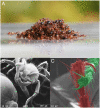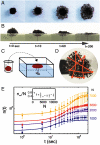Fire ants self-assemble into waterproof rafts to survive floods
- PMID: 21518911
- PMCID: PMC3093451
- DOI: 10.1073/pnas.1016658108
Fire ants self-assemble into waterproof rafts to survive floods
Abstract
Why does a single fire ant Solenopsis invicta struggle in water, whereas a group can float effortlessly for days? We use time-lapse photography to investigate how fire ants S. invicta link their bodies together to build waterproof rafts. Although water repellency in nature has been previously viewed as a static material property of plant leaves and insect cuticles, we here demonstrate a self-assembled hydrophobic surface. We find that ants can considerably enhance their water repellency by linking their bodies together, a process analogous to the weaving of a waterproof fabric. We present a model for the rate of raft construction based on observations of ant trajectories atop the raft. Central to the construction process is the trapping of ants at the raft edge by their neighbors, suggesting that some "cooperative" behaviors may rely upon coercion.
Conflict of interest statement
The authors declare no conflict of interest.
Figures



Similar articles
-
Fire ant rafts elongate under fluid flows.Bioinspir Biomim. 2022 Jun 9;17(4). doi: 10.1088/1748-3190/ac6d98. Bioinspir Biomim. 2022. PMID: 35679139
-
Dynamics and shape of large fire ant rafts.Commun Integr Biol. 2012 Nov 1;5(6):590-7. doi: 10.4161/cib.21421. Commun Integr Biol. 2012. PMID: 23336030 Free PMC article.
-
Fire ants actively control spacing and orientation within self-assemblages.J Exp Biol. 2014 Jun 15;217(Pt 12):2089-100. doi: 10.1242/jeb.093021. J Exp Biol. 2014. PMID: 24920836
-
Raft formation by the red imported fire ant, Solenopsis invicta.J Insect Sci. 2011;11:171. doi: 10.1673/031.011.17101. J Insect Sci. 2011. PMID: 22950473 Free PMC article.
-
Pseudacteon Phorid Flies: Host Specificity and Impacts on Solenopsis Fire Ants.Annu Rev Entomol. 2018 Jan 7;63:47-67. doi: 10.1146/annurev-ento-020117-043049. Epub 2017 Sep 22. Annu Rev Entomol. 2018. PMID: 28938082 Review.
Cited by
-
Wrinkling number and force of a particle raft in compression.Eur Phys J E Soft Matter. 2019 Nov 22;42(11):147. doi: 10.1140/epje/i2019-11913-9. Eur Phys J E Soft Matter. 2019. PMID: 31754917
-
Giant activity-induced elasticity in entangled polymer solutions.Nat Commun. 2025 Jun 12;16(1):5305. doi: 10.1038/s41467-025-60210-9. Nat Commun. 2025. PMID: 40506452 Free PMC article.
-
Amorphous entangled active matter.Soft Matter. 2023 Mar 8;19(10):1952-1965. doi: 10.1039/d2sm01573k. Soft Matter. 2023. PMID: 36809295 Free PMC article.
-
Capillarity-driven migration of small objects: A critical review.Eur Phys J E Soft Matter. 2019 Jan 8;42(1):1. doi: 10.1140/epje/i2019-11759-1. Eur Phys J E Soft Matter. 2019. PMID: 30612222 Review.
-
Attraction, Dynamics, and Phase Transitions in Fire Ant Tower-Building.Front Robot AI. 2020 Mar 4;7:25. doi: 10.3389/frobt.2020.00025. eCollection 2020. Front Robot AI. 2020. PMID: 33501194 Free PMC article.
References
-
- Couzin ID, Krause J. Self-organization and collective behavior in vertebrates. Adv Study Behav. 2003;32:1–75.
-
- Parrish JK, Edelstein-Keshet L. Complexity, patterns, and evolutionary trade-offs in animal aggregation. Science. 1999;284:99–101. - PubMed
-
- Garnier S, Gautrais J, Theraulaz G. The biological principles of swarm intelligence. Swarm Intell. 2007;1:3–31.
-
- Yim M, et al. Modular self-reconfigurable robot systems [grand challenges of robotics] IEEE Robot Autom Mag. 2007;14:43–52.
Publication types
MeSH terms
Substances
LinkOut - more resources
Full Text Sources
Other Literature Sources

